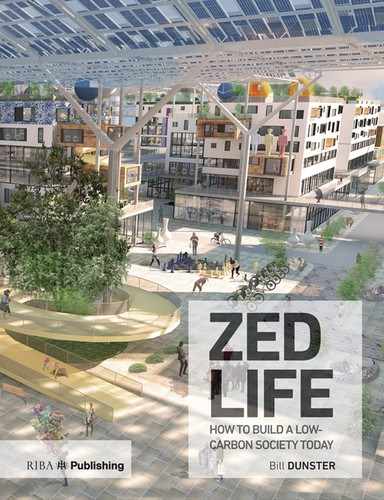Chapter Seventeen
Case Study 7
Higher-Density Strategies: Living Under a Park
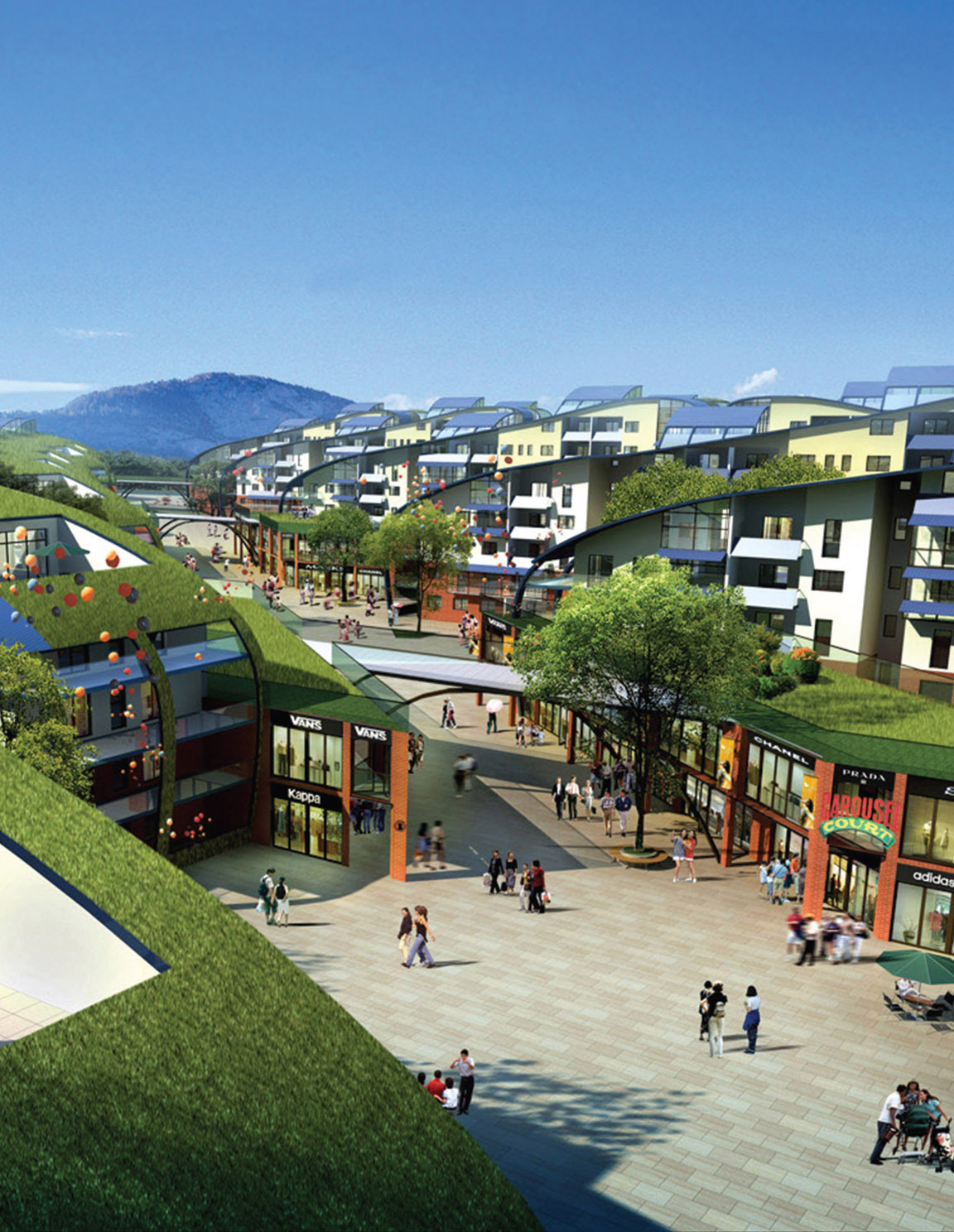
17.1 Pedestrian central shopping street. (Tongshan master plan, Jiangsu, China, 2007).
7a: Elion Master Plan
7b: GS Korea
As climate change accelerates, the urban heat island becomes increasingly problematic. Peak summer temperatures within the city centre are often 3 degrees higher than the surrounding open countryside. Urban wind-speeds decrease due to building cover, so that the hot air from large areas of solar-absorbing asphalt is seldom mitigated by the normal effects of wind. Many facade-mounted air conditioning units simply dump hot air back into the street and only provide a very limited solution and at a considerable cost. To make things worse, air pollution from fossil-fuelled vehicles is trapped at pedestrian level, causing an increase in urban respiratory disease. Despite these disadvantages, property values in city centres tend to escalate steadily, aggravating the problem by increasing density and raising plot ratios. Eventually, the congestion and air pollution must overcome the convenience of the centralised location, at which point the area will be redeveloped and regeneration can be aimed at maximising quality of life. Older cities tend to have been through this process at different periods in their history and, in the best cases, they stabilise at an optimum balance between quality of life, plot ratio and property value.
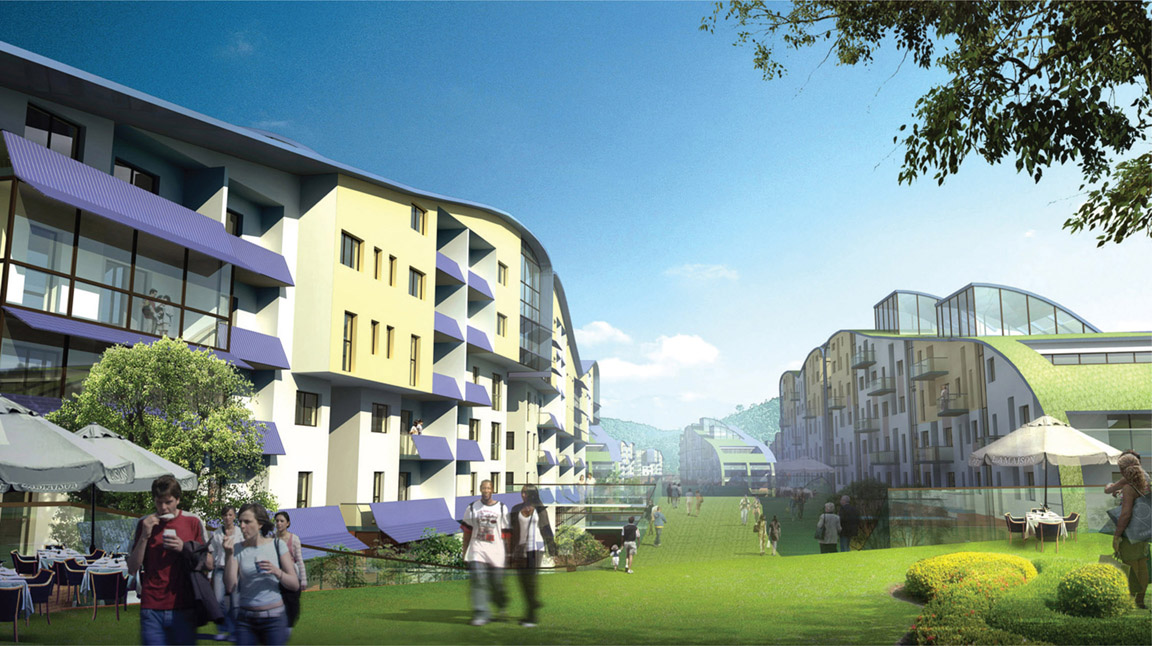
17.2 Typical residential block with parkland over commercial space.
As housing densities increase, the area of roof exposed to sunlight becomes smaller in relation to the number of people. When apartments are built at a density of 100 homes per hectare, the main exposure to sunlight must come from the vertical facades. At the same time, children need outdoor play space and at high densities the provision of green amenity space can be neglected.
ZEDfactory: Creating rooftop parks in city-centre developments
Increasingly ZEDfactory has been asked to look at developments near city centres in places with boom economies, for instance Tongshan in Jiangsu (figs 17.1–17.3) and Dalian Eco-town (fig. 17.4, overleaf). Clients have insisted on meeting their development brief with high-rise point blocks. Visiting these projects, we became increasingly concerned about the dark parking basements, the overshadowed spaces between buildings, and the social alienation inherent in asking families with children to live so far above ground level with little or no open green space. We drew the conclusion that new urban morphologies must address these issues while achieving the same levels of density.
The common theme in these studies is that parkland or inhabited landscape will always be created on the horizontal roof plane, making the roof as easy to access from stair and elevator cores as the street level. This gives residents and workers the option to be outside quickly, away from air pollution and noise, and surrounded by green parkland. Wherever possible this parkland should descend to street level as a cascading hillside, acting as an open invitation to ascend into a more tranquil realm. This typology allows the roof garden to become a linear park, joining the separate building blocks with bridges at high level. This strategy was pioneered at BedZED, and the design specification for robust and permanent roof gardens, with a minimum of 300 mm of soil and raised planters for larger trees and shrubs, has now been perfected (figs 17.1–17.2).
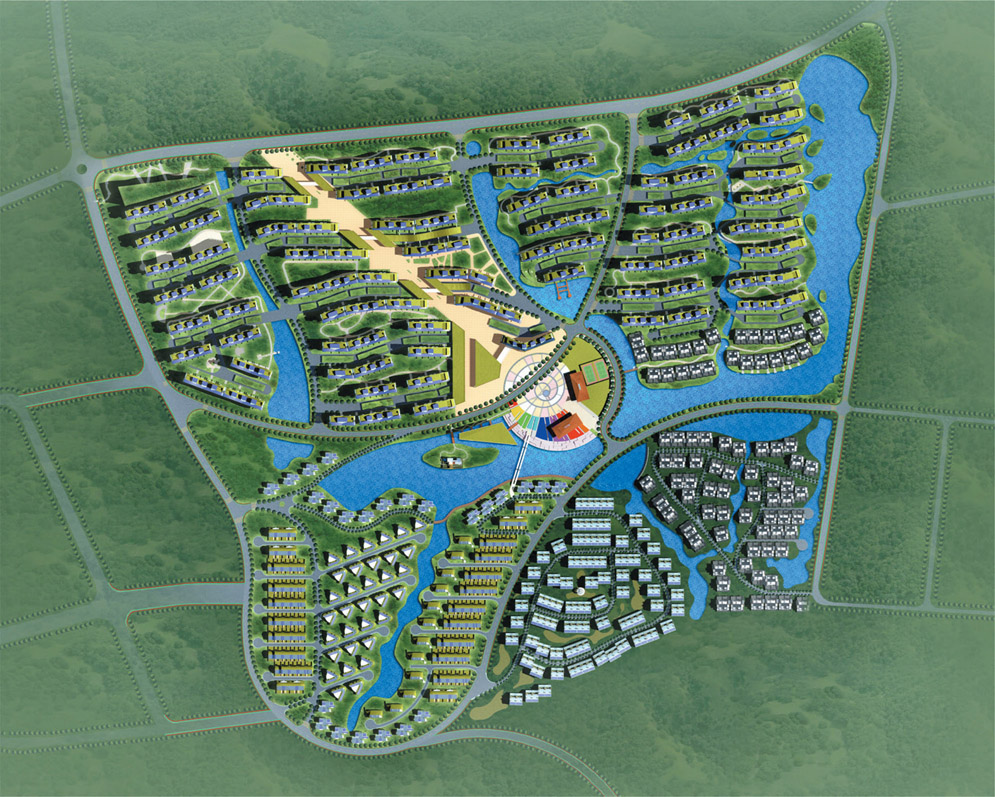
17.3 Site plan of Tongshan master plan.
The cost of extending the lifts another level easily compensates for the additional sales value created by the shared green open space. In many of our projects we can achieve 75% green site coverage, creating a green and pleasant outlook for every home with almost 100% disabled access to the roof garden from each stair core. In many cities, proximity and direct views of parkland increase property values by around 30%. This creates more than enough sales revenue to offset the modest additional construction cost (fig. 17.3).
The most important aspect of this scheme is to connect the roof plane to street level wherever possible, allowing the communal space to be accessed at ground level with steps or ramps that climb higher and higher to the upper floors of the apartment buildings. This sloping parkland feels similar to a hillside or mountainside. A teahouse, or belvedere, can be placed at the highest point – rewarding the climbers and providing exciting views over the surrounding city (fig. 17.4). This idea of bringing the sublime concept of climbable mountainside to ordinary streets has considerable benefits. The urban pressure cooker now has a release valve for those willing to climb uphill.

17.4 View of roof garden, Dalian Eco-town, China, 2012.
Where the roof has become parkland, solar energy harvesting must be reassigned to the vertical plane and it will no longer be so critical to optimise the building orientation. This thinking prompted the development of the self-shading, electric-generating Energy Wall through which every scrap of sunlight can be turned into useful solar electricity. As economies of scale are achieved with this component, the cost becomes comparable to any other durable high-quality rainscreen cladding system. This is the same principle as the myriad of leaves on a forest tree. Each leaf receives little sunlight, and some leaves receive considerably more sunlight than others. The net overall effect is that no sunlight is wasted. Almost no direct sunlight reaches the forest floor. ZEDfactory foresees a future where all larger building surfaces will generate electricity and even at very high plot ratios – up to 50% of annual electric demand can be met from BIPV.
Living under a park
In this section, we are asking how to enhance existing buildings to a ZED standard, with the ultimate goal of making the whole development to be as low carbon as possible. The following two case studies will show how to relocate farming communities in a non-obtrusive way, leaving responsible farming practices in place. These proposed developments are mixed use, incorporating high-rise residential, employment, leisure and retail uses with associated open space within these sites, even in the densest areas.
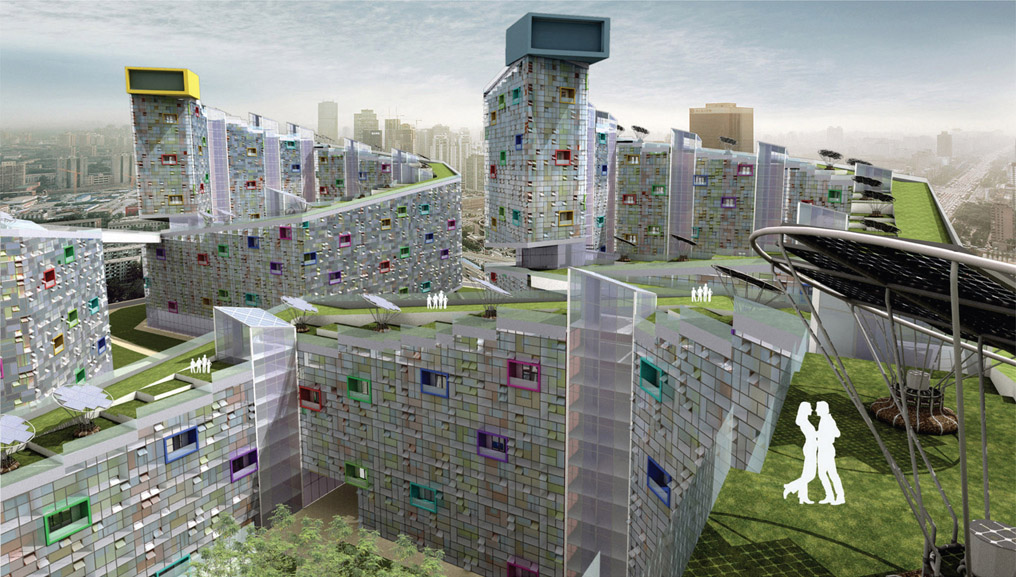
17.5 ParkZED: a theoretical design for high density mixed-use to replace high rise. An EV-only street runs from ground level to roof level, joining up all vertical circulation.
Low-carbon master planning recognises that different habitation densities require different environmental strategies. It is important to develop a new architectural language responding to the considerable climatic variation found across this beautiful planet, where every design decision, every surface and component of a building, helps create a living, breathing organism that gains its beauty as the outcome of energy constraints or of energy flows experienced in time, a form of evolutionary change in reponse to external pressures.
This holistic system-thinking transcends the pragmatic construction process by daring to dream of an attainable zero-carbon zero-waste society.
In this study, the site has been redesigned to incorporate the following features:
- maximum PV potential
- maximum cross-ventilation for natural cooling of apartments
- high levels of daylighting
- convenient walking and cycling
- mixed-use commercial, community and residential units in close proximity
- local farmers’ markets
- zero-waste packaging concepts
- car sharing and car pooling
- maximising the convenience of public transport
- green transport hub
- electric vehicles/e-trike
- green spaces, health and happiness of inhabitants.
The intention is to create an inhabited landscape where people live under a carefully planned sequence of south-facing, solar-harvesting, super-insulated, energy-efficient cliffs of apartments that support a relocation of productive agricultural landscape on all their horizontal surfaces.
Whilea common high-density development will cease to have a relationship to its surrounding landscape, our design delicately places the landscape over the top (fig. 17.6). This integrated building form encourages the connection between the manmade and natural forms as a crucial stage in the quest to get humans to live with a lower carbon footprint.
Our strategy encourages wedge-shaped apartment buildings. As one block rises, the adjacent one falls, allowing higher levels of valuable sunlight to each vertical building facade while if they are staggered on plan, it is possible to maximise long-distance views from most of the apartments (fig. 17.7).

17.6
Object buildings can be wrapped in landscape.

17.7
Dalian master plan site aerial view showing BIPV facades.

17.8 Elion master plan site location.
Case Study 7a
Elion Master Plan
4,200 homes on reclaimed land in Tianjin
The new urban centre of Tianjin occupies a large area of land reclaimed from the sea. Similar in concept to Canary Wharf in London, a business hub built downstream of the historic City on former docklands, it is connected to both the ancient city of Tianjin and the centre of Beijing with high-speed bullet trains. The state-owned developer, appointed by the local government, asked ZEDfactory to master plan a low-carbon community that responded to the location – a wetland lake reserve left over from the land reclamation process (fig. 17.8). At the same time, we were asked to provide a mixture of different value and size of home to serve the new financial district currently under construction. The challenge was to reconcile flood risk with very high-density development and maximize the sales values of the proposed homes by creating a desirable and high-quality public realm.
The ZED master plan has been designed to give the facade of every home the sun-hours needed to generate enough electricity from vertical facade BIPV to power the heating and cooling system and meet the other needs of the majority of every home (fig. 17.9, overleaf). The stepped apartment blocks have shared roof gardens accessed from the stair cores and are raised above the flood plain, with the under-croft available as parking for electric vehicles.
The pedestrian bridge over an existing dual carriageway connects both halves of the site to create a series of child-friendly, safe promenades. Connecting landscaped routes make the community facilities and neighbourhood shops accessible to every home.
A network of cycle and pedestrian paths through parkland connects to the bus stop, making it more convenient to leave the car parked at home.
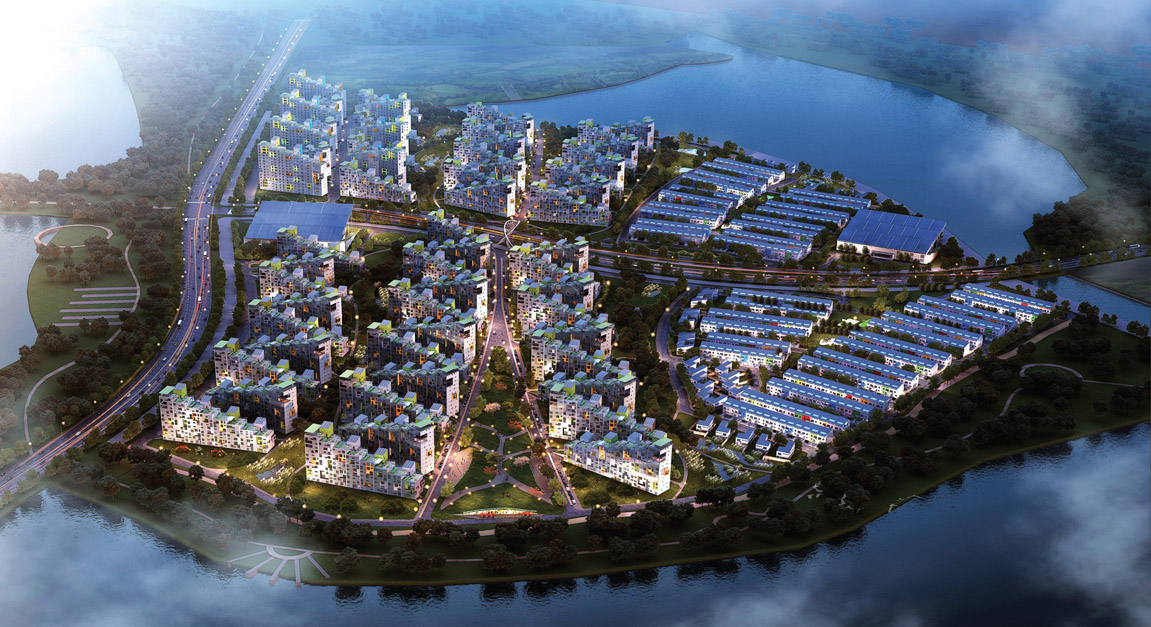
17.9 Elion master plan, Tianjin, China, 2014.

17.10
Elion master plan diagrams.
This also sets up the possibility of each home being sold with an e-bike to encourage the use of a full range of transport options. The traffic access still required to dwellings can be achieved at reduced road speeds of 15 mph so that cars do not dominate the development and pedestrians and vehicular traffic are largely separate.
An access road is located along the green corridor that provides privacy for residents and a scenic route back to the home. The villas are located as far as possible away from the roads and close to the nature reserve and water. Public facilities are distributed through the site with hotel, club, sport and a commercial street located at the north corner of the park. These amenities enjoy the beautiful view of the water. The business block is located near the south-east entrance to the site. Schools located to the east and south of the site can use the green open spaces on the site for recreational facilities.
The majority of parking is underground with the ground plane free of cars. A small proportion is at ground level for drop-off and for disabled access. To help with navigation, visitor parking is also on the surface plane (fig. 17.10).
Case Study 7b
GS Korea
Downtown Seoul
The buildings that make up this mixed-use complex form perimeter blocks. Arranged like a rising hillside, they are organised to form four large open courtyards, where residents of the luxury apartments can gather to interact, play sports and enjoy the area. The site contains 434 apartment units of various sizes, virtually the same number as those proposed by a more conventional rival scheme, and adds 3,500 m2 of community area. The blocks rise from 4 to 17 storeys. By creatively using the space, the net site-wide green area, including the open water, represents 62% green foliage coverage for the housing and 70% for the recreational spaces (fig. 17.11).
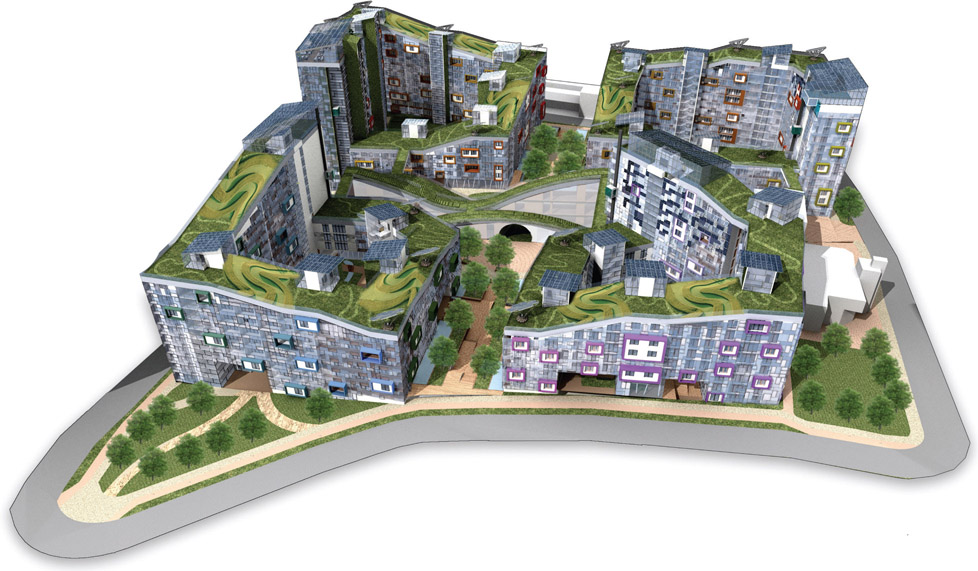
17.11
Overview of GS Korea project.
The same density of apartments has been achieved as the client’s alternative high-rise typology, despite being, on average, eight floors lower. On the roof level trail, hidden among the shrubs and trees, are several exercise areas, Korean-style picnic tables and even a ‘natural’ spring for filtered drinking water. All lift cores reach the roof level and
17.12 GS Korea diagrams.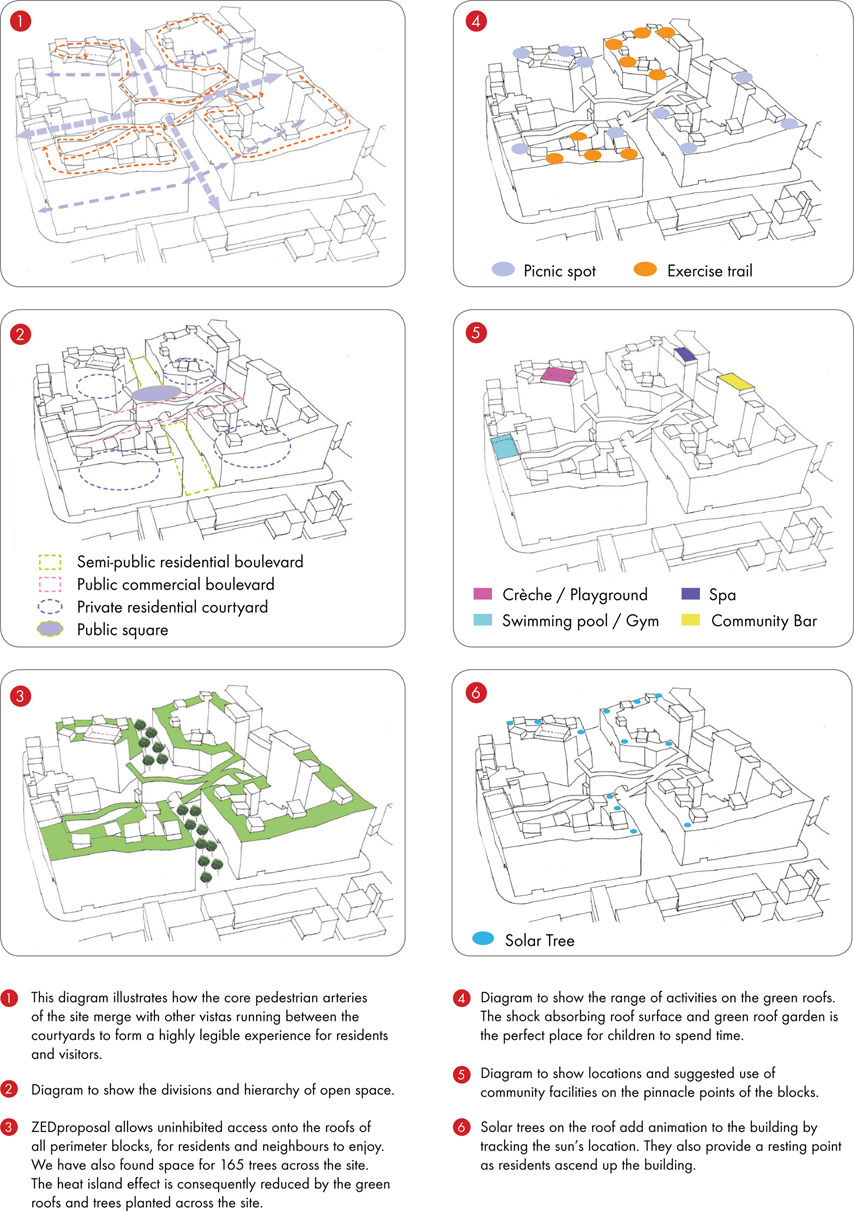
pedestrians can access all the green roofs via the central commercial building.
The market at the heart of the scheme, located in a sunken amphitheatre, works during the day as a food market, while at night it can function as an open air cinema. It also serves an important role as being a meeting space for social interaction and the cultural centre of the scheme (fig. 17.12).
Car clubs, an idea well-established in Europe, can easily be established in South Korea or, for that matter, anywhere in Asia. One car club vehicle replaces the need for six private vehicles, thus reducing the parking requirements of a site. This in turn reduces construction cost, embodied carbon and so on. Crucially, it means that the site requires just one level of basement car parking. Car club access points are located in the underground parking level, in the centre of the courtyards, convenient from all cores. The development also encourages private EV use with multiple charging points and good site access. If the lifts were increased in size so that small electric vehicles could be parked in each apartment hallway, then a radical improvement on conventional apartment typologies would become possible.
The cost saved by not building extensive basement parking can be reinvested in providing each apartment with a compact electric vehicle and access to a communal conventional electric powered car pool.
An alternative is to reduce basement car parking by introducing specially designed e-trike lifts. Residents could park their e-trikes directly outside their apartments, with only a single level of semi-basement parking needed, and naturally ventilated to reduce energy requirements on-site (figs 17.13–17.14).
This plan favours the uninhibited movement, charging and refuelling of zero-emission personal transport vehicles, with charging points in every parking bay, taking power from the building integrated PV panels. A charge takes around six hours, and gives a range of around 100 km. In the public areas, charging points are located under the solar trees. Here, electricity comes from both the PV integrated into the tree, and also the wider PV network, or pyrolysis sub-grid.
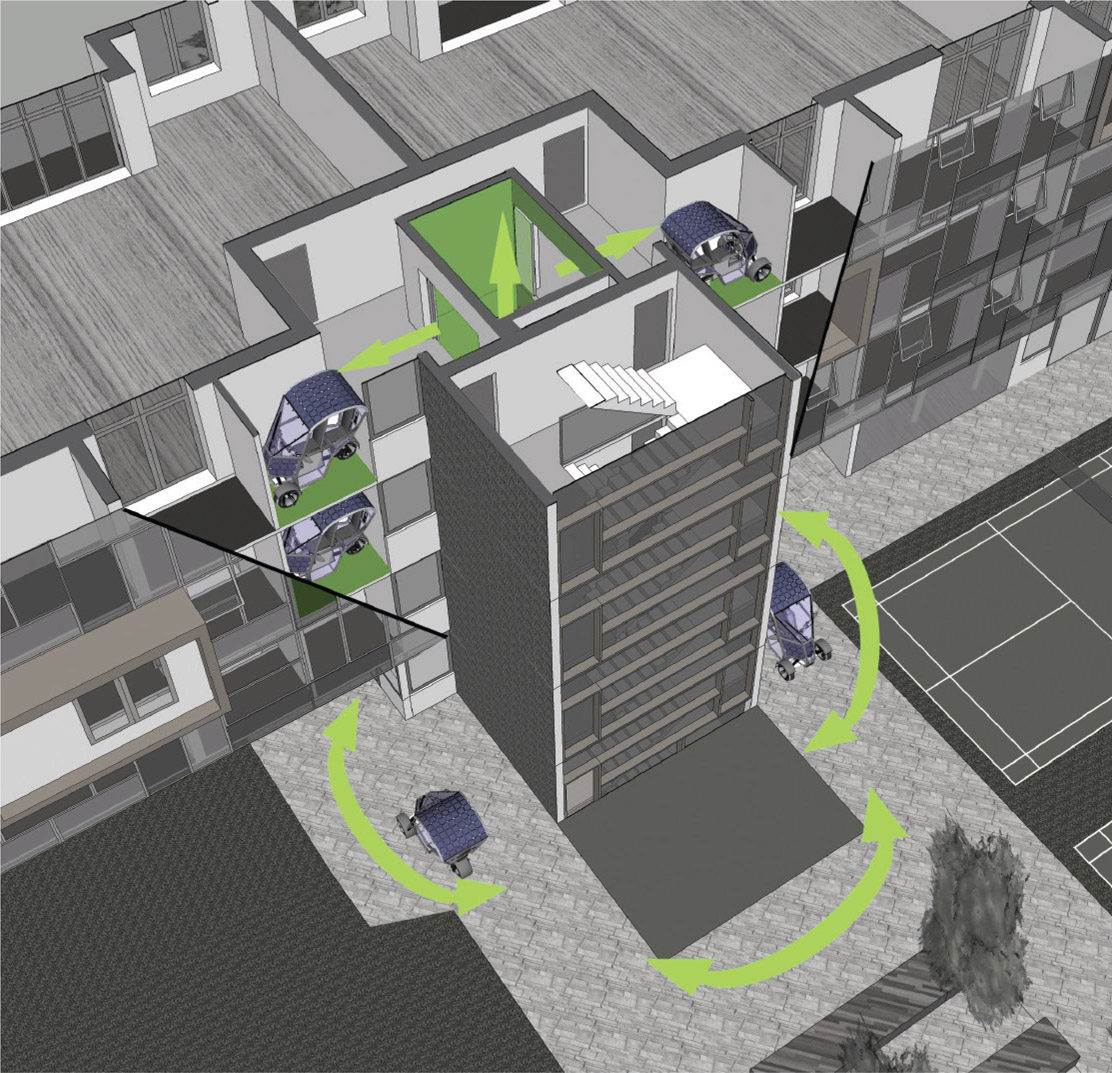
17.13
Cutaway revealing storage locations of e-trikes outside apartments.

17.14
Section to show the vertical movement of e-trikes through the buildings.
Insulated roof terraces
Much like the Dalian Eco town, the Elion master plan includes green roof terraces for residents and visitors to enjoy, helping to reduce the effect of the urban heat island (fig. 17.15).
The roof terraces are formed from large one-metre high steps, which rise as the building gradually increases in height. Each core is hidden underneath these green allotments, but still rises high enough to have level access to the roof gardens for less able-bodied people and pushchairs.
By placing a duplex maisonette at the highest point of each set of four apartments and cutting down the height of the lift shaft, the profile of the core has been kept low, with less impact upon the south facade shape. The roof of the large core can then provide extra allotment space.
In the void spaces underneath the allotments, rainwater storage tanks have been fitted with the capacity of 78 m3, enough for two months’ supply of water in the dry season. Add several large cupboard spaces for storing tools and seeds for the farmers and the need for unsightly sheds on the roof is eliminated. Space within the top floor of the core is also available for the storage of tools.
The green roof is mostly used for allotments, providing the top apartments with vegetable gardens, while the lower apartments are served on the ground level. The different types of planting on the allotments will make a vegetation patchwork, with a variety that will add to the pleasure of the walking up towards the tearoom.
Integrating renewable energy systems
The results of the building physics modelling on the Seoul project have shown that the likely energy consumption of the new ZED-designed block could potentially be 730,000 kWh which is equivalent to 56 kWh/m2/year.

17.15
Solar cool facade system with roof.
Potential carbon savings
Using heat pumps would produce a saving of 14% CO2 over the base case conventional typology and specification.
Installing solar hot water tubes to supplement heat pumps would lead to a 19% CO2 saving.
Installing PV on the facades of the building, while using heat pumps, would produce a 46% CO2 saving.
A combination of PV on the facades and the flat roofs of the cores, along with solar hot water panels on the facades, plus heat pumps, would produce the greatest saving of 81% Co2 over the base case.
In order to get a 100% reduction in carbon emissions on the Seoul development, 480 extra horizontal PV panels would need to be installed, which would take up an area of 840 m2. This extra electricity could also be provided by a pyrolysis unit using organic and agricultural waste from the residents installed in the local neighbourhood waste transfer station (figs 17.16–17.17, overleaf).
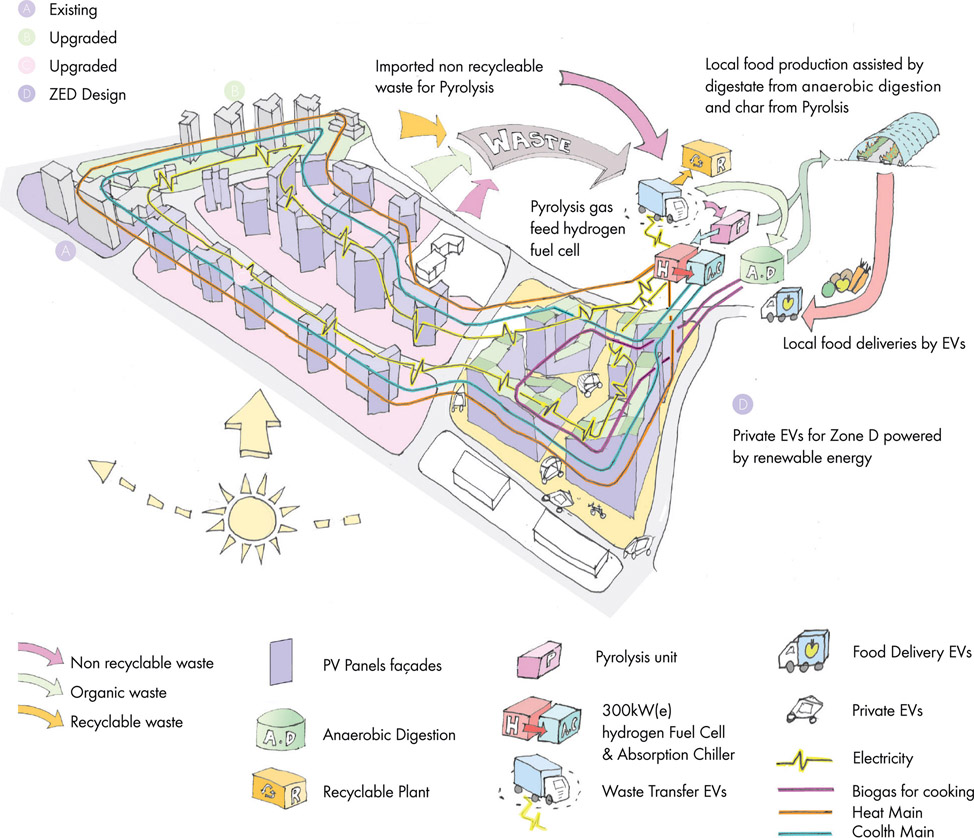
17.16
Zero-carbon zero-waste strategy applied to urban high density master plan.

17.17 M&E Strategy Specification.
Conclusion
The zero-carbon zero-waste concept has informed every aspect of each master plan, creating desirable spaces in between the buildings and, we predict, translating into considerably higher sales values than the more traditional high-rise development strategies currently favoured. The saving on not having to build expensive underground parking should fund the whole rooftop park construction, demonstrating that many of the features can approach cost neutrality. Reductions in the cost of monocrystalline PVs from China now result in this durable electricity-producing material being the same price as industry standard terracotta rainscreen cladding. European ‘Passivhaus’ standards of energy efficiency reduce energy demand to the point where renewable energy can meet all of the new development’s requirements, sometimes importing from the city grid and sometimes exporting to it.
In a traditional scheme the density dominates without regard to the quality of life, interest or well-being of the inhabitants, but we have deliberately struck a balance between amenity and density. By combining solar energy harvesting with maximum energy efficiency, the homes are made more comfortable to live in and cheaper to run. The extensive planted roof terraces and landscaped gardens potentially provide displaced and re-housed local smallholders with employment and an easier transition from their current relatively low-density lifestyle. Usually when a city expands it takes away small agricultural plots in the process, but it is now possible to integrate almost the same area of small allotments and vegetable gardens on the horizontal surfaces of the new developments. Contemporary green roof technology makes this both possible and affordable. This approach suggests that high-density dwelling combined with public/private amenity space, which is so lacking in current conventional high-rise developments, could provide a new benchmark for urban expansion or regeneration.
Residents will be able to live low-carbon lifestyles surrounded by parkland, in comfortable apartments, with convenient transport options and locally produced food. As the cost of conventional energy rises, these homes and workspaces will increase in value, showing the developer to be the market leader in providing future-proofed homes in an era of scarce resources, rising lifestyle costs and energy insecurity. Let’s see how these ideas raise property values and outperform conventional urbanism in a competitive market (fig. 17.18).

17.18
View of Elion master plan.
